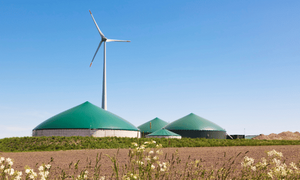Turning waste into energy: A deep dive into biogas and biomethane

Every year, more than 105 billion tonnes of organic waste is produced worldwide, leading to the release of methane and other greenhouse gas emissions. These organic wastes consist of food waste, sewage, garden waste, as well as farm and agricultural waste. Currently, only 2% of these wastes are properly treated and recycled.
What is biogas?
Biogas is a renewable energy source produced through the anaerobic digestion of organic matter. The process involves microorganisms breaking down these organic materials in the absence of oxygen, resulting in a gas mixture primarily composed of methane (CH₄) and carbon dioxide (CO₂), with small amounts of other gases like hydrogen sulfide (H₂S) and ammonia (NH₃).
Biogas is not a fossil fuel. Fossil fuels, such as coal, oil and natural gas are formed from the remains of ancient plants and animals that have been subjected to heat and pressure over millions of years. In contrast, biogas is produced from contemporary organic materials through relatively quick biological processes.
What is the difference between biogas and biomethane?
Biogas and biomethane are related but have distinct differences.
The main distinction between biogas and biomethane lies in their composition. Biogas consists of a mixture of various gases, primarily methane and carbon dioxide. In contrast, biomethane undergoes a purification process that removes carbon dioxide, hydrogen sulfide, and water resulting in a cleaner fuel.
What makes biogas a viable source of renewable energy?
Biogas is considered a viable source of renewable energy for several reasons:
-
Abundance of waste: Biogas can be produced from a wide range of organic materials, including agricultural waste, manure, municipal waste, plant material, sewage, green waste, and food waste.
-
Reduced greenhouse gas emissions: Biogas production helps to mitigate greenhouse gas emissions in multiple ways. Firstly, it captures methane that would otherwise be released into the atmosphere during the decomposition of organic matter. Secondly, when biogas is used as a fuel, it displaces the use of fossil fuels, which produce greenhouse gas emissions when burned.
-
Waste management: Biogas production can help address waste management challenges by diverting organic waste from landfills and incinerators.
-
Renewable and continuous: Unlike fossil fuels, which are finite and take millions of years to form, biogas is continuously produced through natural processes.
-
Versatility: Biogas can be used for various energy applications, including electricity generation, heating, and cooking. It can also be upgraded to biomethane and injected into the natural gas grid or used as a transportation fuel, providing versatility in its use across different sectors.
What do fossil fuels and biofuels have in common?
It's essential to recognise the differences between fossil fuels and biofuels, particularly regarding their sources, environmental impacts, and sustainability.
While fossil fuels are non-renewable resources, biofuels are considered renewable energy alternatives.
Hydrogen production from biogas
It is possible to produce hydrogen using biogas.
This potential is currently being explored. An example of this is the BIONICO project, which aims to develop and test a membrane reactor for hydrogen production from biogas. Key conventional technologies under investigation for this purpose include steam reforming and autothermal reforming.
In the BIONICO project, two types of biogas are considered: one derived from landfill and the other from anaerobic digestion. The purification of biogas is a critical step before hydrogen production.
These findings support the viability of biogas as a sustainable source for hydrogen production, potentially contributing to the broader adoption of hydrogen as a clean energy carrier.
